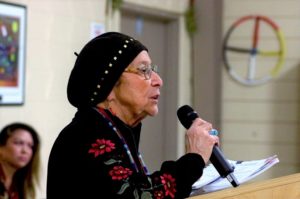Returning children to community care at heart of Elders gathering

By Rick Garrick
THUNDER BAY — Anishinaabemowin skills, traditional practices and information on childcare and customary care were among the highlights at Nokiiwin Tribal Council’s Giiniwenama Elders Gathering. The gathering was held on Jan. 30-31 at the Ka-Na-Chi-Hih Specialized Solvent Abuse Treatment Centre in Thunder Bay.
“I try to use [Anishinaabemowin] as much as I can as it was the language I was brought up into,” says Biinjitiwaabik Zaaging Anishinaabek (BZA) Elder Jim Mishquart, who emceed the gathering. “I also was teaching some of the people that wanted to learn certain phrases or wording that I was taught.”
Mishquart says it was “awesome” to meet with the Elders at gathering, who were mainly from the five Nokiiwin communities, which include Fort William, Pic Mobert and BZA.
“A lot of them I know because of emceeing in their communities for their summer gatherings,” Mishquart says. “It was an awesome group to see them all come together, and it was really good dialogue.”
Fort William Elder Marlene Pierre, a head Elder with Nokiiwin, says the gathering was “a wonderful two days.”
“We’ve learned so much from each other especially the Elders telling their stories — that was best for me, the highpoint,” Pierre says, noting she also appreciated the information shared on taking care of children. “There was a lot of other information provided as well, and Nokiiwin has done a great job once more in bringing our people together. They were from all over our territory, and everyone had a great story to share especially with respect to traditional roles and our experiences growing up.”
Jennifer McKenzie, restorative justice coordinator with Nokiiwin, says the Elders wanted to talk about how the communities can take care of their own children.
“This is what is at the heart of the Elders, they wanted to talk about how our communities can take responsibility for taking care of their own children,” McKenzie says. “The response was that language is very important for us to connect back to our culture, also that we need to get back to the land and we need to gather together more often at gatherings like this.”
McKenzie says the gathering also included video interview sessions where participants had an opportunity to share their thoughts and life experiences for future reference.
“It’s going to be a great information [resource] that we can share back with the communities,” McKenzie says. “We’re going to create a mini-documentary and the information that we’ve gathered here will be shared with the Nokiiwin communities.”

Cathy Bellefeuille, a Nipissing First Nation citizen and lawyer who delivered two presentations on Circle Process for Child and Youth Wellbeing and Customary Care, Adoption and Kinship, says there was a “very positive” response from the participants.
“A lot of people came with their own stories and their own concerns, but I think with the Child Well-being Law, people want to know more about it,” Bellefeuille says. “They want to know about the engagement sessions, they also want to be a part of the consultations.”
Ramona Thompson, director of Rocky Bay (BZA) Family Services, also delivered a presentation on Returning Children to Community Care.
“It’s about our community taking back our child welfare and being able to support our families and being able to advocate no matter where they are,” Thompson says. “Our key goal is to have no kids in care and have our children have an understanding of our community at least, but at the most is be able to come home to our community.”

